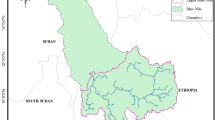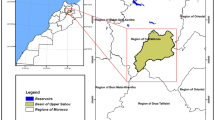Abstract
Hydrological models are the main tools for water resources management. The Lavras Simulation of Hydrology (LASH) model was developed for watersheds with scarce data, and great results have been obtained in Brazil. This study aimed to incorporate hydrological response units (HRUs) in the LASH model to assess soil water storage (SWS) across space and time. The LASH model was calibrated and validated for the Grande River basin upstream of the Furnas Hydropower Plant, in southeastern Brazil. The Nash-Sutcliff coefficient (CNS) and its logarithmic version were analyzed in terms of both calibration and validation to appraise the model’s performance in a daily time step. The CNS for calibration and validation was 0.86 and 0.77, respectively, showing that LASH using the HRUs produced improvements in the simulations. The calibrated parameters showed a good relationship with hydrological processes in HRUs, and SWS estimates reflected the soils, topography, and land use of the watershed. LASH could describe the SWS behavior and identify the sub-watersheds with the highest and the lowest values. Therefore, the LASH model is a promising tool for SWS simulation in time and space.





Similar content being viewed by others
References
Allen RG, Pereira LS, Raes D, Smith M (1998) Crop evapotranspiration: guidelines for computing crop water requirements. FAO, irrigation and drainage. Paper no. 56, Rome
Alvarenga LA, Mello CR, Colombo A, Cuartas LA, Bowling LC (2016) Assessment of land cover change on the hydrology of a brazilian headwater watershed using the distributed hydrology-soil-vegetation model. Catena 143:7–17
Alves GJ, Mello CR, Beskow S, Junqueira Junior JA, Nearing MA (2019) Assessment of the soil conservation service-curve number method performance in a tropical oxisol watershed. J Soil Water Conserv 74:500–512
Beskow S, Norton LD, Mello CR (2013) Hydrological prediction in a tropical watershed dominated by Oxisols using a distributed hydrological model. Water Resour Manag 27:341–363
Bueno EO, Alves GJ, Mello CR (2020) Hydroelectricity water footprint in Parana hydrograph region. Brazil Renew Energy 162:596–612
Caldeira TL, Mello CR, Beskow S, Timm LC, Viola MR (2019) LASH hydrological model: an analysis focused on spatial discretization. Catena 173:183–193. https://doi.org/10.1016/j.catena.2018.10.009
Companhia Energética de Minas Gerais, Universidade Federal de Lavras (2018) Modelo Fitográfico da Bacia do Rio Grande. http://sig.projetoriogrande.ti.lemaf.ufla.br/. Accessed 20 March 2018
Cunge JA (1969) On the subject of a flood propagation computation method (Muskingum method). J Hydraul Res 7:205–230. https://doi.org/10.1080/00221686909500264
Fernandes Filho EI, Curi N (2010) Mapa de solos do estado de Minas Gerais. Fundação Estadual Do Meio Ambiente, Belo Horizonte
Han H, Kim J, Chandrasekar V, Choi J, Lim S (2019) Modeling Streamflow enhanced by precipitation from Atmospheric River using the NOAA National Water Model: a case study of the Russian River basin for February 2004. Atmosphere 10:466. https://doi.org/10.3390/atmos10080466
Havrylenko SB, Bodoque JM, Srinivasan R, Zucarelli GV, Mercuri P (2016) Assessment of the soil water content in the pampas region using SWAT. Catena 137:298–309
Junqueira Junior JA, Mello CR, Owens PR, Mello JM, Curi N, Alves GJ (2017) Time-stability of soil water content (SWC) in an Atlantic forest - Latosol site. Geoderma 288:64–78
Khan U, Ajami H, Tuteja NK, Sharma A, Kim S (2018) Catchment scale simulations of soil moisture dynamics using an equivalent cross-section based hydrological modelling approach. Journal of Hydrology 564:944–966. https://doi.org/10.1016/j.jhydrol.2018.07.066
Liu M, Adam JC, Rickey AS, Zhu Z, Myneni R (2018) Factors controlling changes in evapotranspiration, runoff, and soil moisture over the conterminous U.S.: accounting for vegetation dynamics. J Hydrol 565:123–137
Ma Y, Li X, Guo L, Lin H (2017) Hydropedology: interactions between pedologic and hydrologic processes across spatiotemporal scales. Earth-Sci Rev 171:181–195. https://doi.org/10.1016/j.earscirev.2017.05.014
Mello CR, Ávila LF, Lin H, Nunes MCS, Chappell N (2019) Water balance in a neotropical forest catchment of southeastern Brazil. Catena 173:9–21
Mello CR, Viola MR, Norton LD, Silva AM, Weimar FA (2008) Development and application of a simple hydrologic model simulation for a Brazilian headwater basin. Catena 75:235–247
Mishra SK, Singh VP (2003) SCS-CN method. In: soil conservation service curve number (SCS-CN) methodology. Water science and technology library, springer, Dordrecht
Mishra SK, Singh VP, Sansalone JJ, Aravamuthan V (2003) A modified SCS-CN method: characterization and testing. Water Resour Manag 17(1):37–68
Moriasi DN, Gitau MW, Pai N, Daggupati P (2015) Hydrologic and water quality models: performance measures and evaluation criteria. T ASABE 58(6): 1763-1785. DOI https://doi.org/10.13031/trans.58.10715
Nash JE, Sutcliffe JV (1970) River flow forecasting through conceptual models part I: a discussion of principles. J Hydrol 10(3):282–290. https://doi.org/10.1016/0022-1694(70)90255-6
Neitsch SL, Arnold JG, Kiniry JR, Williams JR (2005) Soil and Water Assessment Tool: theoretical documentation - version 2005. Grassland, soil and water research laboratory - Agricultural Research Service; Blackland Research Center - Texas Agricultural Experiment Station, Temple, Texas, USA
Oliveira VA, Mello CR, Viola MR, Srinivasan R (2017) Assessment of climate change impacts on streamflow and hydropower potential in the headwater region of the Grande river basin, southeastern Brazil. Int J Climatol 37:5005–5023
Parinussa RM, Yilmaz MT, Anderson MC, Hain CR, Jeu RAM (2014) An intercomparison of remotely sensed soil moisture products at various spatial scales over the Iberian Peninsula. Hydrol Process 28:4865–4876
Pinto LC, Mello CR, Owens PR, Norton LD, Curi N (2015) Role of Inceptisols in the hydrology of mountainous catchments in southeastern Brazil. J. Hydrol. Eng. 21 (2): 05015017. https://doi.org/10.1061/(ASCE)HE.1943-5584.0001275
Rawls WJ, Ahuja LR, Brakensiek DL, Shirmohammadi A (1993) Infiltration and soil water movement. In: Maidment DR (ed) Handbook of hydrology. McGraw-Hill, New York, pp 1–51
Troch PA, Carrillo G, Sivapalan M, Wagener T, Sawicz K (2013) Climate-vegetation-soil interactions and long-term hydrologic partitioning: signatures of catchment co-evolution. Hydrol Earth Syst Sci 17:2209–2217
Van Liew MW, Arnold JG, Garbrecht JD (2003) Hydrologic simulation on agricultural watersheds: choosing between two models. T ASABE 46:1539–1551
Viola MR, Mello CR, Beskow S, Norton LD (2013) Applicability of the LASH model for hydrological simulation of the Grande River basin. Brazil J Hydrol Eng 18:1639–1652. https://doi.org/10.1061/(ASCE)HE.1943-5584.0000735
Zhuo L, Han D, Daí Q, Islam T, Srivastava PK (2015) Appraisal of NLDAS-2 multi-model simulated soil moistures for hydrological modelling. Water Resour Manag 29:3503–3517
Acknowledgments
We thanks to CNPq (Grant number 301556/2017-2), FAPEMIG (Grand number PPM 545-18) and CAPES for doctorate scholarship to the first author.
Availability of Data and Materials
The data that support the findings of this study are available from the corresponding author upon reasonable request.
Funding
This study received funds from CNPq (Grant number 301556/2017–2), FAPEMIG (Grand number PPM 545–18) and CAPES for doctorate scholarship to the first author.
Author information
Authors and Affiliations
Contributions
- Nayara P.V. Andrade: Conduction of analyses; Methodology; Interpretation of the results.
- Marcelo R. Viola: Methodology; Interpretation and analyze of the results; Co-supervision; Visualization.
- Samuel Beskow: Methodology; Conceptualization; Formal Analyses; Writing – revised version.
- Tamara L. Caldeira: Formal Analyses; Methodology; Visualization.
- Li Guo: Conceptualization; Editing original version.
- Carlos R. Mello: Supervision; Methodology; Formal Analyses; Writing – original draft; Resources.
Corresponding author
Ethics declarations
Ethical Approval
The authors declare that they have no conflict of interest.
Consent to Participate
The authors declare that they are aware and consent with their participation on this paper.
Consent to Publish
The authors declare that they are consent with the publication of this paper.
Competing Interests
There is not any competing interest.
Additional information
Publisher’s Note
Springer Nature remains neutral with regard to jurisdictional claims in published maps and institutional affiliations.
Supplementary Information
ESM 1
(DOCX 85 kb)
Rights and permissions
About this article
Cite this article
Andrade, N.P.V., Viola, M.R., Beskow, S. et al. Assessment of Spatial and Temporal Soil Water Storage Using a Distributed Hydrological Model. Water Resour Manage 34, 5031–5046 (2020). https://doi.org/10.1007/s11269-020-02711-4
Received:
Accepted:
Published:
Issue Date:
DOI: https://doi.org/10.1007/s11269-020-02711-4




